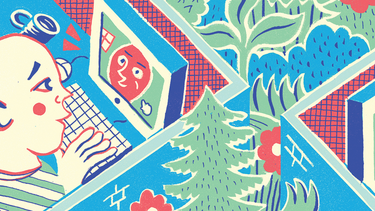Leading through COVID: A Vast Experiment in Remote Work
In this series, we talk with Yale SOM alumni about their professional and personal lives during the global pandemic. Scott Wharton ’95, who leads Logitech’s video collaboration group, sees far-reaching and sustained changes from the remote work explosion forced on us by the pandemic.

Sean David Williams
Adapted from a phone interview, April 8, 2020.
Like a lot of people, I’m sequestering in place at home in Silicon Valley. It has been four weeks; California started earlier than a lot of the country. My team has been using video for 100% of our meetings for years. In that sense, it’s not that big a change. Often, there would be several of us in a conference room while others would be remote, but even with everyone remote now, our workflow is not that different.
In terms of my own setup, I was like the shoemaker who didn’t have shoes. I’d sit in the kitchen with my laptop for video calls and annoy everyone else in the house. Right before this all happened, I finally set up an office with an external monitor, webcam, and mouse and keyboard in the former dining room. It makes a big difference to have a decent place to work.
Logitech is Zoom’s biggest hardware partner. Zoom had 10 million users a day in December. Now they have 200 million. We’re doing well from that, sadly for unfortunate reasons.
We’re scrambling to make more stuff in a world where supply chains are topsy-turvy, and tariffs are still in place. We’re having to think differently. A billion people started working from home practically overnight. Zoom saw 20X growth. Order of magnitude changes are a challenge for cloud platform; for a hardware company it’s a lot to adapt to.
Fortunately, China is coming out of their crisis and those supply chains are roughly working. But if there’s a part from Thailand, Vietnam, Malaysia, Taiwan, or Europe, those suppliers may be shut down. You realize how interconnected and how fragile the system is.
Usually, when there’s a crisis—political instability or a natural disaster—it’s localized. Now the crisis is happening almost everywhere. I think people, including us, are going to relook at the global trading system. Dual sourcing and other kinds of resilience are getting a lot of attention.
Internally, Logitech as a company hasn’t missed a beat and is coping well, although it has been really hard. I think this model of everyone working remotely is proving to be pretty resilient. But the company had already allowed work from anywhere. It is something you have to learn to do. We’ve helped a lot of our clients not just with the technical parts but the cultural pieces. It’s hard to imagine what this might have looked like if it had happened even five or ten years ago.
We’ve also provided free webcams and headsets to teachers who might not have the right tools to teach from home. The values that I learned at SOM are coming to the fore—thinking about how societies work, how business, government, and nonprofits work together, and being a good leader who does the right thing even if it hurts the bottom line sometimes. That’s what’s needed now.
When we announced the program for teachers, we were overwhelmed and oversubscribed within 24 hours. Because of Logitech’s inventory challenges, I had to fight to make sure everything got shipped to the teachers. It is the right thing to do. It makes a difference.
Looking longer term, as we come out of this, I think we will see existing trends accelerate. More people working remotely, at least some of the time. There’s no reason for it to be all or nothing. I have engineers who need to be in a lab most of the time. And then there are some people who don’t ever need to be in the office. But for many people, there will be more room for a hybrid.
Those shifts in where we work may have broader impacts. When I started my company in 2008, 25% of our fundraising went to rent. If I were doing it today, there’s no way I would spend money on rent. I would go all virtual. At the time, we didn’t have Zoom. Now we do, and I think the social pressure of “You’re not a real company unless you have an office” is diminishing.
As work from home becomes more common, I think the structure of our houses will change. For a while the living room was the space everyone cared about. Now the kitchen is the coveted room. I think the workspace will get its turn. Most existing houses don’t have good workspaces but new houses and condos will start to include them. It makes sense to prioritize if you’re working remotely and spending eight hours a day or more in it.
It’s going to take time to see how these things play out, but for now, since I’m not going to meet clients in person, I’m doing a lot more presentations, webinars, seminars, “Ask Me Anything” sessions that I couldn’t do before because I was traveling so much. I’m doing those both externally and internally. In some ways, I feel more connected to people because I have more time for conversations and check-ins than I did before.